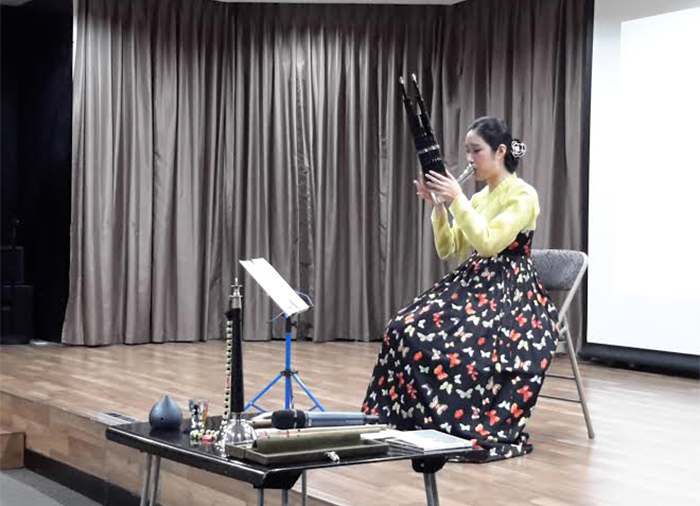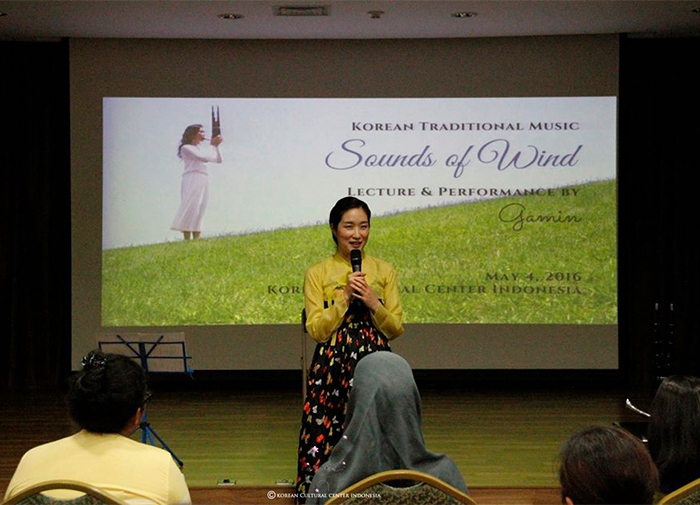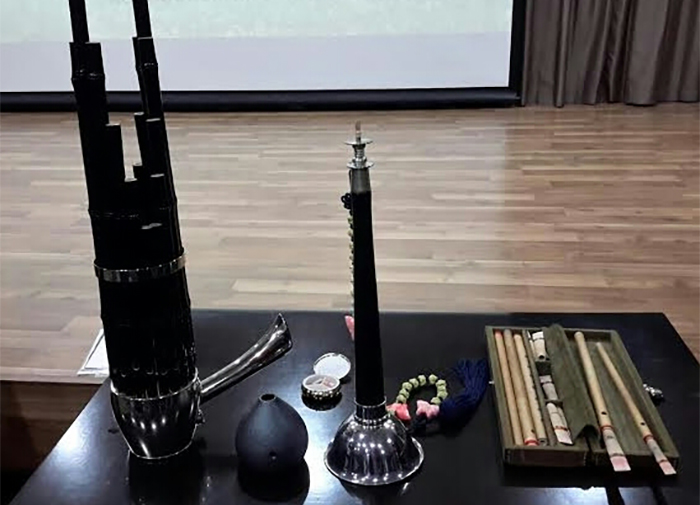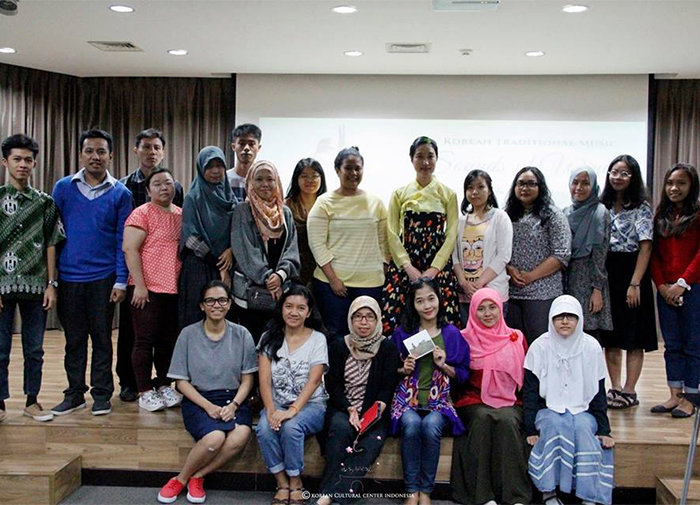View this article in another language
- 한국어
- English
- 日本語
- 中文
- العربية
- Español
- Français
- Deutsch
- Pусский
- Tiếng Việt
- Indonesian

Gamin plays traditional Korean musical instruments.
It feels that I really hear the sounds of wind when Gamin plays the traditional Korean musical instruments piri, a double reed bamboo wind instrument similar to an oboe, and saenghwang, a free reed mouth organ made from 17 bamboo pipes. The melody and the strains of the soft music sound pleasing to the ear, like a breeze that soothes the soul. So I think the title on the invitation, “Gamin, Sounds of Wind,” fits with the performance that Gamin presented that day.
I was lucky enough to attend Gamin’s lecture and performance, held at the Korean Cultural Center Indonesia (KCCI) in Jakarta earlier this month. This Korean female musician not only attracted an audience with her elegant and charming personality, but also gave us a deep insight into Korean traditional musical instruments, with which Indonesian society is not so familiar.
Gamin actually visited Indonesia to perform at the ASEAN Literary Festival 2016. She took time out of her schedule to introduce and share her knowledge about traditional Korean musical instruments that have become her trademark, such as the saenghwang, the piri, the hun, a clay or ceramic flute similar to an ocarina, and the taepyongso, a double reed wind instrument also similar to an oboe.
Her personal website says that Gamin is a true pioneer and innovator, taking those instruments in exciting new directions. It also says that Gamin appears virtually unlimited as to the kind of sounds she can get out of her instruments. We know from those comments that Gamin is a well-known traditional musician with an international reputation.

Gamin gives a lecture.
In her lecture at the KCCI, Gamin said that she basically only plays piano and started to get interested in learning the saenghwang, piri, taepyongso and hun only when she was a senior in high school. That’s what impressed me about her, during a time when the younger generation in Korea today prefers to plunge into the world of commercialism and modern music. Gamin consistently stayed on track to play and perform traditional music, popularizing it around the world.
“I want people around the world to know that Korea is not only K-pop and soap operas, but Korea also has a variety of traditional music and instruments, and also folk songs that are unique and beautiful,” Gamin said.
Gamin has produced five albums so far and has travelled around the world to hold concerts. She also collaborates with international musicians and works on various musical projects. According to her profile, she was once a member and assistant principal player at the Contemporary Gukak Orchestra, part of the National Gukak Center, the center for training and preserving Korean traditional music.
In her lecture and performance at the KCCI, Gamin showed her high skills, truly creating the sounds of the wind. She played "Sangryungsan" on the piri, "Suryongeum" on the saenghwang and "Arirang" on the taepyongso. The audience really liked her performance and gave her a big round of applause. After the lecture, Gamin patiently answered questions from the enthusiastic youngsters who were still interested in asking her more about traditional Korean music.
Here are brief descriptions of the instruments Gamin played. I hope it enhances your knowledge about Korea, mainly its traditional music and arts.

Left to right: Saenghwang, Hun, Taepyongso and Piri
1. Piri
The piri is a cylindrical double-reed bamboo oboe with eight finger holes, one on the back for the thumb, and seven on the front. It’s large reed and cylindrical bore gives it a sound that's a bit mellower than many other types of oboes. The piri is an essential instrument and is popularly used in both folk music and classical court music. There are other piris, like the hyang piri and the dang, or tang, piri, classified by the period in which they were imported from China.
2. Saenghwang
The saenghwang is a Korean wind instrument. It’s a free reed mouth organ derived from, and quite similar to, the Chinese sheng, though its tuning is different. The saenghwang is constructed from 17 bamboo pipes, each with a metal free reed mounted vertically in a windchest.
In contrast to other traditional Korean instruments, it's not well known today, even in Korea, and very few musicians are able to play it. It's used primarily in chamber music, usually in combination with instruments such as the danso, a vertical flute, and the yanggeum, a hammered dulcimer. The instrument was referred to historically as the sang.
3. Hun
The hun is one of the few Korean instruments that has been played in Korean Confucian temples since its arrival from Song China in the 1100s. It's very similar to the ocarina found in various musical traditions around the world. The hun is made of clay and it can be formed in several shapes, including the classic egg, a ball or a hemisphere. The Korean hun is normally shaped like a hemisphere. The instrument has one blowhole at the top, two holes on the back and three finger-holes on the belly. It's capable of playing all twelve distinct tones,which are quite low and dark.
4. Taepyongso
The taepyongso, a large wind instrument also called the hojok, hojeok nallari or saenap, is a Korean double reed wind instrument in the oboe family, probably descended from the Persian zuma and closely related to the Chinese suona. It has a conical wooden body made from citron, jujube or yellow mulberry wood, with a metal mouthpiece and a cup-shaped metal bell. The loud and piercing sound it produces has kept it confined mostly to Korean folk music and to marching bands. It’s also used sparingly in other genres of music, including Confucian, Buddhist and Shamanist ritual music.
You can learn more about Gamin here: http://gamin-music.com/?ckattempt=1.

Gamin and the audience poses for a photo.
By Magdalena Krisnawati
Honorary Reporter
Photos: Magdalena Krisnawati, the Korean Cultural Center in Indonesia